Programming To Patterns
10 likes1,091 views
The document discusses how to write JavaScript code using classes and patterns. It begins by showing an example of how code was written without classes. It then demonstrates how to implement classes in JavaScript by creating base classes, extending classes, and composing classes. The benefits of writing code using classes such as reusability and readability are discussed. The document also provides tips for when and how to write classes in JavaScript.
1 of 46
Downloaded 74 times
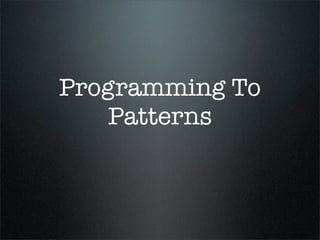


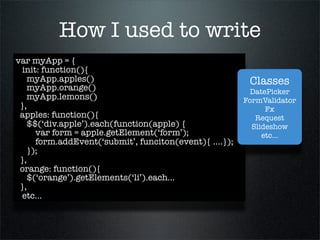
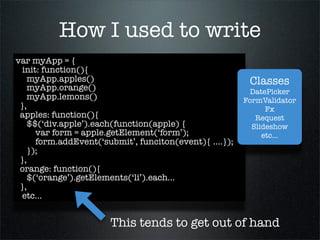
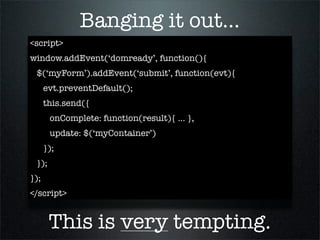
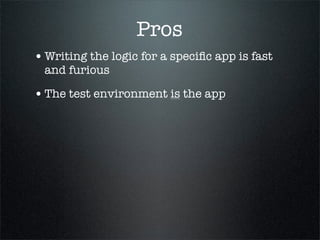





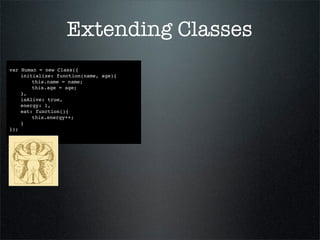
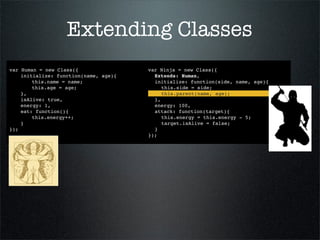

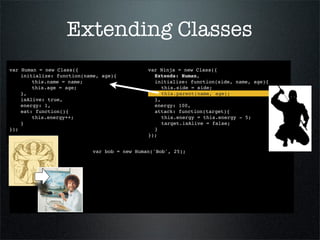
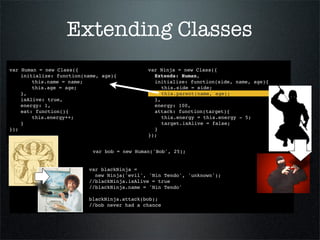

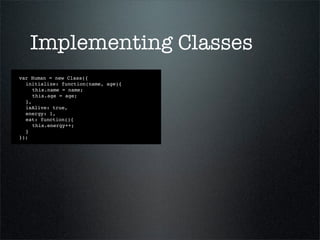
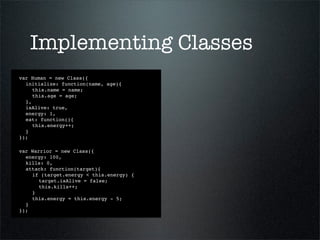
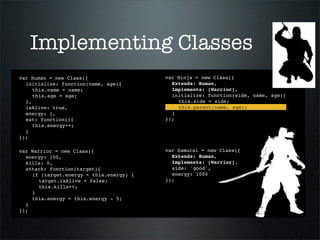






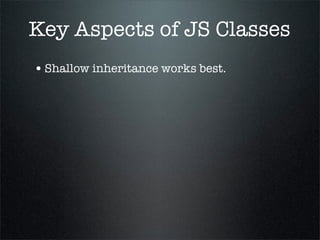
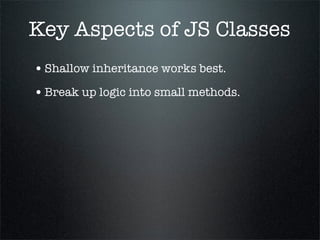
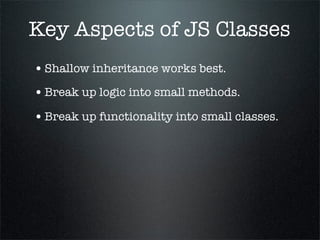

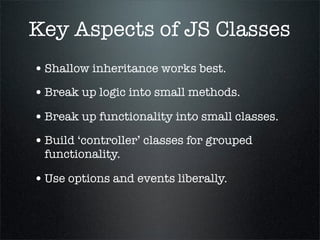
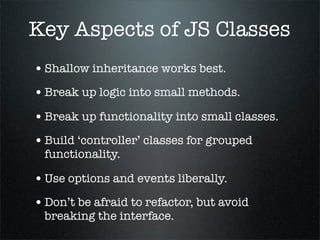
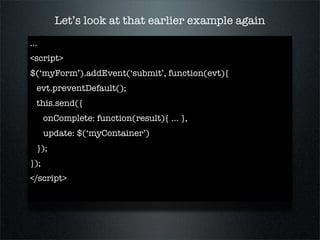
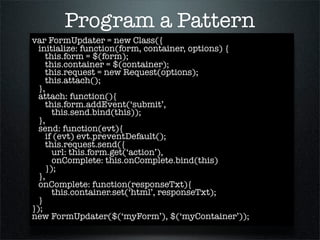


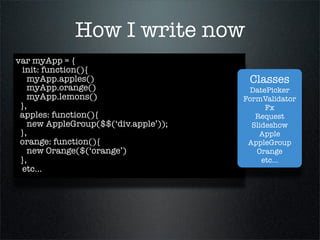
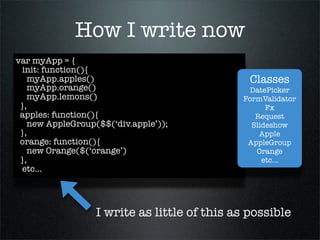
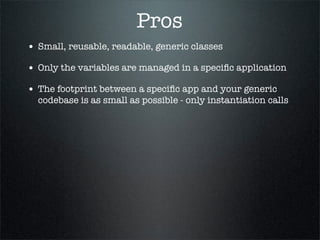
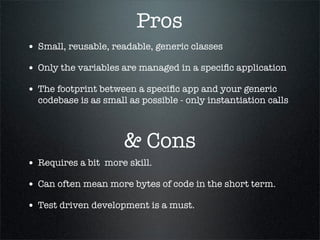





Ad
Recommended
ddd+scala



ddd+scala潤一 加藤 DDDをScalaでどうやって実装していくかという話題。前半はScalaの適当な紹介と、その後にDDDのビルディングブロックをScalaコード上に反映するにはどうするかって話です。残りのサンプルは時間がなくて説明していません。すみません。
Prototype UI Intro



Prototype UI IntroJuriy Zaytsev The document summarizes a library of UI components called Prototype UI that provides reusable JavaScript components like windows, carousels, and menus. It is developed by a core team and community contributors. Components are highly customizable, skinnable, and have a consistent API. The document provides examples of creating windows that can be dragged and minimized to a desktop icon.
Coffee Scriptでenchant.js



Coffee Scriptでenchant.jsNaoyuki Totani The document defines several JavaScript concepts including classes, inheritance, and object-oriented programming principles. It defines an Animal class that is extended by a Snake class which overrides the move method. It also defines SceneMain class that extends an enchant.Scene class, a constructor function, and a Hoge class with a getter method to return the name property.
Fabric.js @ Falsy Values



Fabric.js @ Falsy ValuesJuriy Zaytsev Fabric.js is a JavaScript canvas library that simplifies canvas rendering and provides an interactive object model for canvas elements. It allows creating and manipulating canvas elements and objects in a more simplified way compared to using the native canvas API. The library provides features like animation, events, SVG parsing, text rendering, and supports multiple browsers. Future plans include reducing the library size, improving documentation, and adding touch support.
FunScript 2013 (with speakers notes)



FunScript 2013 (with speakers notes)Zach Bray FunScript/F# is the only statically-typed compile-to-js language poised to take full advantage of the JavaScript ecosystem. F#'s type providers make consuming JavaScript possible without any code generation or foreign function interface definition. FunScript has taken the first steps to making this a reality by consuming TypeScript definitions files. However, the F# community has more ambitious plans to consume pure JavaScript files too. Seamless integration with the node package manager might also be on the horizon. Find out more at: http://funscript.info/ http://fsharp.org/ and http://zbray.com/
Empathic Programming - How to write comprehensible code



Empathic Programming - How to write comprehensible codeMario Gleichmann Slides to a (non-commercial) talk i gave 2011 at XPUG Rhein/Main (Germany) about how to write comprehensible code, regarding cognitive abilities of human mind.
Useful functions for arrays in php



Useful functions for arrays in phpChetan Patel This document provides descriptions and examples of useful functions for manipulating arrays in PHP. It lists functions for getting array size, values and keys; adding, removing, and sorting elements; merging, reversing, and randomizing arrays; searching arrays; slicing arrays; removing duplicate values; and applying functions to array elements.
Scala-对Java的修正和超越



Scala-对Java的修正和超越Caoyuan Deng This document provides an overview of Scala and compares it to Java in 3 sentences:
Scala is a multi-paradigm programming language that runs on the Java Virtual Machine and interoperates seamlessly with Java, combining object-oriented and functional programming in one concise, high-level language. Scala improves on Java with features like closures, pattern matching, traits, and immutable data while maintaining a familiar syntax; it compiles to Java bytecode and allows Java and Scala code to interoperate. Scala aims to be a better language for writing concurrent, parallel and distributed applications than Java with its support for actors, futures and software transactional memory.
1.2 scala basics



1.2 scala basicsfuturespective This document summarizes some of the key differences between Scala and Java syntax. It covers topics like type definitions, variables, methods, classes, traits, collections, exceptions, control flow, and packages. Overall, the document shows that Scala code is more concise and expressive than equivalent Java code for many common programming constructs.
обзор Python



обзор PythonYehor Nazarkin This document discusses using Python for web development. Some key points:
- Python is a flexible, open source language that is well-suited for web projects due to its extensive standard library, third-party modules, and large developer community.
- Python code tends to be more readable and maintainable than other languages like Java or PHP due to Python's simplicity, readability-focused syntax, and support for functional programming patterns.
- Python web frameworks provide batteries included functionality like template engines, object relational mappers, caching, and asynchronous request handling that speed up development.
- Python's extensive standard library and ecosystem of third-party modules provide solutions for common tasks like localization, testing, debugging
About java



About javaJay Xu This document provides an overview and agenda for a presentation about Java. It discusses Java history, object-oriented programming concepts like classes and interfaces, inheritance and polymorphism, exception handling, primitive types and wrappers, inner classes, generics, and new features introduced since Java 5 such as varargs, enhanced for loops, annotations, and auto boxing/unboxing. The presentation covers these topics over multiple slides with code examples.
かとうの Kotlin 講座 こってり版



かとうの Kotlin 講座 こってり版Yutaka Kato The document demonstrates various Kotlin programming concepts including:
1. Classes, objects, properties and methods are defined to represent a Person with a name and age.
2. Functions like maxBy() are used to find the oldest person by comparing their age properties.
3. Different ways of handling null values safely are shown using elvis operator and safe calls.
4. Control flow structures like if/else and when are demonstrated along with various operators.
Scala in practice



Scala in practiceandyrobinson8 This document provides an overview of Scala and compares it to Java. It discusses Scala's object-oriented and functional capabilities, how it compiles to JVM bytecode, and benefits like less boilerplate code and support for functional programming. Examples are given of implementing a simple Property class in both Java and Scala to illustrate concepts like case classes, immutable fields, and less lines of code in Scala. The document also touches on Java interoperability, learning Scala gradually, XML processing capabilities, testing frameworks, and tool/library support.
JavaYDL11



JavaYDL11Terry Yoast Here are the key differences between overriding and overloading:
- Overriding involves subclass and superclass, while overloading involves only one class.
- Overriding changes the implementation of an existing method in the superclass, while overloading provides multiple implementations of the same method name with different parameters.
- The parameter lists are the same for overriding but different for overloading.
- Overriding is achieved by the subclass, while overloading is achieved by a single class.
So in summary, overriding changes the implementation of a method in the subclass, while overloading provides multiple implementations of the same method name with different parameters within one class.
Hammurabi



HammurabiMario Fusco Hammurabi is an internal domain-specific language (DSL) for rule-based programming implemented in Scala. It allows domain experts to write rules in plain Scala code without learning a new language. Rules are evaluated by a rule engine that executes matching rules on a working memory of facts. The DSL aims to be readable, flexible and leverage Scala features like autocompletion. It also supports priorities, selecting objects, and exiting or failing evaluation. The architecture uses actors for concurrent rule evaluation. Future work includes improving performance using RETE algorithm and providing alternative selection methods.
A bit about Scala



A bit about ScalaVladimir Parfinenko Выступление в рамках спецкурса "Немейнстримовые технологии разработки", читаемого в НГУ. http://bit.ly/mainstreamless
Аудио дорожка работает, но нужно иметь некоторое терпение, так как грузится она не моментально.
深入浅出Jscex



深入浅出Jscexjeffz This document discusses JavaScript Computation Expressions (Jscex), which allows writing asynchronous JavaScript code in a synchronous-looking style using computation expressions. Key points:
- Jscex uses computation expressions to write asynchronous JavaScript code that looks synchronous using constructs like $await.
- Asynchronous functions can be defined and composed together asynchronously and parallel using $await without callbacks or promises.
- This allows asynchronous code to be written in a way that resembles synchronous code for readability while still maintaining asynchrony under the hood.
Scala for Jedi



Scala for JediVladimir Parfinenko This document discusses Scala features for parallelism, concurrency, and reactive programming. Some key points include:
- Scala supports parallel collections that can perform operations like map, reduce, and filter in parallel.
- Futures represent asynchronous computations whose results are not yet known. They allow non-blocking operations.
- Actors are units of concurrency that communicate asynchronously by message passing. They encapsulate state and behavior.
- Akka is a toolkit for building highly concurrent, distributed, and fault-tolerant event-driven applications using actors. It implements the actor model in Scala.
Kotlin on Android: Delegate with pleasure



Kotlin on Android: Delegate with pleasureDmytro Zaitsev This document discusses Kotlin delegation and how it can be used to extend class behavior without subclassing. It provides examples of external and internal delegation in Kotlin. It also discusses how properties in Kotlin can be delegated to other objects by implementing interfaces like ReadOnlyProperty or using standard delegates from the Kotlin library. Real-world use cases demonstrated include binding views in Android, using dependency injection frameworks like Dagger, creating custom views, and binding shared preferences in a type-safe way. The document encourages exploring how to build type-safe APIs on top of other APIs like bundles and cursors using delegation.
Scala for Java programmers



Scala for Java programmers輝 子安 This document provides an introduction to the Scala programming language for Java programmers. It discusses Scala's motivation as a scalable and more productive alternative to Java. Key features covered include static typing, object-oriented and functional programming, traits, pattern matching, and actors. Examples are provided to illustrate concepts like functions as first-class values, partially applied functions, and collection operations. The document concludes by mentioning additional Scala concepts and providing references for further reading.
JavaYDL6



JavaYDL6Terry Yoast The document discusses arrays in Java programming. It defines an array as a data structure that holds a collection of the same type of data. Arrays allow programmers to store and access multiple values in a single variable. The document covers how to declare array variables, create arrays, initialize arrays, access array elements using indexes, and perform common operations on arrays such as finding minimum/maximum values.
SWDC 2010: Programming to Patterns



SWDC 2010: Programming to Patternsdylanks Slides from SWDC conference on June 2, 2010. Talk compares simple approaches to patterns using Dojo and MooTools.
Introduction To Scala



Introduction To ScalaInnar Made This document provides an overview of Scala, covering object-oriented programming concepts, functional programming concepts, and how Scala combines both paradigms. It discusses key Scala features like type inference, anonymous classes, generics, and immutable collections. It provides examples of common programming tasks like filtering, mapping, reducing collections as well as examples of recursion and higher-order functions. The document demonstrates how to implement functional objects like an immutable Rational number class in both Java and Scala style.
Javascript best practices



Javascript best practicesManav Gupta This document provides best practices for writing JavaScript code. It recommends using strict comparison operators (=== and !==), declaring variables with 'var' to avoid globals, adding comments with /* */, using object literals for configuration, validating external data, optimizing loops, and using dot and bracket notation wisely based on property visibility. Braces {} should be used to clearly delimit blocks. Variable types should not be changed after declaration and shortcuts like conditionals (?:) can optimize code.
2.1 recap from-day_one



2.1 recap from-day_onefuturespective This document provides a recap of concepts covered on day 1 of a Scala training, including:
- How variables, methods, classes, tuples, and the Option type work differently in Scala compared to Java.
- Key Scala features like first class functions, closures, pattern matching, and traits.
- An overview of the schedule for day 1 which includes higher order functions, implicit conversions, XML support, and building a quiz game task.
Shibuya.js Lightning Talks



Shibuya.js Lightning Talksjeresig ECMAScript 4 proposed many new features like classes, inheritance, and interfaces but faced significant opposition over security concerns and the large number of changes. This led to ECMAScript 5 as a compromise with fewer new features focused on JSON parsing, strict mode, and object properties. Processing.js allows visualization programming using a Processing-like language that runs in JavaScript and HTML5 Canvas across browsers. jQuery Mobile aims to fill the gap of cross-browser mobile web development support beyond modern WebKit browsers.
Scala 2013 review



Scala 2013 reviewSagie Davidovich Slides from my talk at the Junction (Jan 24, 2013)
Single-core performance has hit a ceiling, and building web-scale multi-core applications using imperative programming models is nightmarishly difficult. Parallel programming creates a new set of challenges, best practices and design patterns. Scala is designed to enable building scalable systems, elegantly blending functional and object oriented paradigms into an expressive and concise language, while retaining interoperability with Java. Scala is the fastest growing JVM programming language, being rapidly adopted by leading companies such as Twitter, LinkedIn and FourSquare.
This presentation provides a comprehensive overview of the language, which managed to increase type safety while feeling more dynamic, being more concise and improving readability at the same time. We will see how Scala simplifies real life problems by empowering the developer with powerful functional programming primitives, without giving up on the object oriented paradigm. The overview includes tools for multi-core programming in Scala, the type system, collection framework and domain-specific languages. We’ll explore the power of compile-time meta-programming, which is made possible by the newly released Scala 2.10, and get a glimpse into what to expect from 2.11 in 2014.
We will also see how Scala helps overcome the inherent limitations of Java, such as type erasure, array covariance and boxing overhead.
Multiple examples emphasize how Scala pushes the JVM harder than any other mainstream language through the infinite number of boilerplate busters, increased type safety and productivity boosters from a Java developer’s perspective.
FITC CoffeeScript 101



FITC CoffeeScript 101Faisal Abid This document introduces Faisal Abid and provides a brief summary of his background and work experience. It mentions that he is a software engineer and entrepreneur who works on the tablet team at Kobo. It also lists some things he has worked on and blogs about, including the history of JavaScript and CoffeeScript.
CoffeeScript



CoffeeScriptNone CoffeeScript is a programming language that compiles to JavaScript. It adds syntactic sugar that makes JavaScript cleaner and adds features inspired by Python and Ruby. Key features include cleaner syntax for functions, objects, conditionals, loops, and classes. CoffeeScript code compiles directly to equivalent JavaScript code, so it can be used anywhere JavaScript is used like web browsers and Node.js. To use CoffeeScript, install the CoffeeScript compiler and use it to compile CoffeeScript files to JavaScript for use in projects.
OO JS for AS3 Devs



OO JS for AS3 DevsJason Hanson The document compares and contrasts object-oriented programming concepts between JavaScript and ActionScript 3. Some key differences include:
- JavaScript uses prototypes instead of classes for inheritance and does not have keywords like "extends"
- Scope in JavaScript functions can be tricky due to closures
- Animation in JavaScript requires manually redrawing the entire canvas each frame rather than updating individual objects
- Interactivity on HTML5 canvas elements only occurs at the canvas level rather than on child objects
Ad
More Related Content
What's hot (15)
1.2 scala basics



1.2 scala basicsfuturespective This document summarizes some of the key differences between Scala and Java syntax. It covers topics like type definitions, variables, methods, classes, traits, collections, exceptions, control flow, and packages. Overall, the document shows that Scala code is more concise and expressive than equivalent Java code for many common programming constructs.
обзор Python



обзор PythonYehor Nazarkin This document discusses using Python for web development. Some key points:
- Python is a flexible, open source language that is well-suited for web projects due to its extensive standard library, third-party modules, and large developer community.
- Python code tends to be more readable and maintainable than other languages like Java or PHP due to Python's simplicity, readability-focused syntax, and support for functional programming patterns.
- Python web frameworks provide batteries included functionality like template engines, object relational mappers, caching, and asynchronous request handling that speed up development.
- Python's extensive standard library and ecosystem of third-party modules provide solutions for common tasks like localization, testing, debugging
About java



About javaJay Xu This document provides an overview and agenda for a presentation about Java. It discusses Java history, object-oriented programming concepts like classes and interfaces, inheritance and polymorphism, exception handling, primitive types and wrappers, inner classes, generics, and new features introduced since Java 5 such as varargs, enhanced for loops, annotations, and auto boxing/unboxing. The presentation covers these topics over multiple slides with code examples.
かとうの Kotlin 講座 こってり版



かとうの Kotlin 講座 こってり版Yutaka Kato The document demonstrates various Kotlin programming concepts including:
1. Classes, objects, properties and methods are defined to represent a Person with a name and age.
2. Functions like maxBy() are used to find the oldest person by comparing their age properties.
3. Different ways of handling null values safely are shown using elvis operator and safe calls.
4. Control flow structures like if/else and when are demonstrated along with various operators.
Scala in practice



Scala in practiceandyrobinson8 This document provides an overview of Scala and compares it to Java. It discusses Scala's object-oriented and functional capabilities, how it compiles to JVM bytecode, and benefits like less boilerplate code and support for functional programming. Examples are given of implementing a simple Property class in both Java and Scala to illustrate concepts like case classes, immutable fields, and less lines of code in Scala. The document also touches on Java interoperability, learning Scala gradually, XML processing capabilities, testing frameworks, and tool/library support.
JavaYDL11



JavaYDL11Terry Yoast Here are the key differences between overriding and overloading:
- Overriding involves subclass and superclass, while overloading involves only one class.
- Overriding changes the implementation of an existing method in the superclass, while overloading provides multiple implementations of the same method name with different parameters.
- The parameter lists are the same for overriding but different for overloading.
- Overriding is achieved by the subclass, while overloading is achieved by a single class.
So in summary, overriding changes the implementation of a method in the subclass, while overloading provides multiple implementations of the same method name with different parameters within one class.
Hammurabi



HammurabiMario Fusco Hammurabi is an internal domain-specific language (DSL) for rule-based programming implemented in Scala. It allows domain experts to write rules in plain Scala code without learning a new language. Rules are evaluated by a rule engine that executes matching rules on a working memory of facts. The DSL aims to be readable, flexible and leverage Scala features like autocompletion. It also supports priorities, selecting objects, and exiting or failing evaluation. The architecture uses actors for concurrent rule evaluation. Future work includes improving performance using RETE algorithm and providing alternative selection methods.
A bit about Scala



A bit about ScalaVladimir Parfinenko Выступление в рамках спецкурса "Немейнстримовые технологии разработки", читаемого в НГУ. http://bit.ly/mainstreamless
Аудио дорожка работает, но нужно иметь некоторое терпение, так как грузится она не моментально.
深入浅出Jscex



深入浅出Jscexjeffz This document discusses JavaScript Computation Expressions (Jscex), which allows writing asynchronous JavaScript code in a synchronous-looking style using computation expressions. Key points:
- Jscex uses computation expressions to write asynchronous JavaScript code that looks synchronous using constructs like $await.
- Asynchronous functions can be defined and composed together asynchronously and parallel using $await without callbacks or promises.
- This allows asynchronous code to be written in a way that resembles synchronous code for readability while still maintaining asynchrony under the hood.
Scala for Jedi



Scala for JediVladimir Parfinenko This document discusses Scala features for parallelism, concurrency, and reactive programming. Some key points include:
- Scala supports parallel collections that can perform operations like map, reduce, and filter in parallel.
- Futures represent asynchronous computations whose results are not yet known. They allow non-blocking operations.
- Actors are units of concurrency that communicate asynchronously by message passing. They encapsulate state and behavior.
- Akka is a toolkit for building highly concurrent, distributed, and fault-tolerant event-driven applications using actors. It implements the actor model in Scala.
Kotlin on Android: Delegate with pleasure



Kotlin on Android: Delegate with pleasureDmytro Zaitsev This document discusses Kotlin delegation and how it can be used to extend class behavior without subclassing. It provides examples of external and internal delegation in Kotlin. It also discusses how properties in Kotlin can be delegated to other objects by implementing interfaces like ReadOnlyProperty or using standard delegates from the Kotlin library. Real-world use cases demonstrated include binding views in Android, using dependency injection frameworks like Dagger, creating custom views, and binding shared preferences in a type-safe way. The document encourages exploring how to build type-safe APIs on top of other APIs like bundles and cursors using delegation.
Scala for Java programmers



Scala for Java programmers輝 子安 This document provides an introduction to the Scala programming language for Java programmers. It discusses Scala's motivation as a scalable and more productive alternative to Java. Key features covered include static typing, object-oriented and functional programming, traits, pattern matching, and actors. Examples are provided to illustrate concepts like functions as first-class values, partially applied functions, and collection operations. The document concludes by mentioning additional Scala concepts and providing references for further reading.
JavaYDL6



JavaYDL6Terry Yoast The document discusses arrays in Java programming. It defines an array as a data structure that holds a collection of the same type of data. Arrays allow programmers to store and access multiple values in a single variable. The document covers how to declare array variables, create arrays, initialize arrays, access array elements using indexes, and perform common operations on arrays such as finding minimum/maximum values.
SWDC 2010: Programming to Patterns



SWDC 2010: Programming to Patternsdylanks Slides from SWDC conference on June 2, 2010. Talk compares simple approaches to patterns using Dojo and MooTools.
Introduction To Scala



Introduction To ScalaInnar Made This document provides an overview of Scala, covering object-oriented programming concepts, functional programming concepts, and how Scala combines both paradigms. It discusses key Scala features like type inference, anonymous classes, generics, and immutable collections. It provides examples of common programming tasks like filtering, mapping, reducing collections as well as examples of recursion and higher-order functions. The document demonstrates how to implement functional objects like an immutable Rational number class in both Java and Scala style.
Similar to Programming To Patterns (20)
Javascript best practices



Javascript best practicesManav Gupta This document provides best practices for writing JavaScript code. It recommends using strict comparison operators (=== and !==), declaring variables with 'var' to avoid globals, adding comments with /* */, using object literals for configuration, validating external data, optimizing loops, and using dot and bracket notation wisely based on property visibility. Braces {} should be used to clearly delimit blocks. Variable types should not be changed after declaration and shortcuts like conditionals (?:) can optimize code.
2.1 recap from-day_one



2.1 recap from-day_onefuturespective This document provides a recap of concepts covered on day 1 of a Scala training, including:
- How variables, methods, classes, tuples, and the Option type work differently in Scala compared to Java.
- Key Scala features like first class functions, closures, pattern matching, and traits.
- An overview of the schedule for day 1 which includes higher order functions, implicit conversions, XML support, and building a quiz game task.
Shibuya.js Lightning Talks



Shibuya.js Lightning Talksjeresig ECMAScript 4 proposed many new features like classes, inheritance, and interfaces but faced significant opposition over security concerns and the large number of changes. This led to ECMAScript 5 as a compromise with fewer new features focused on JSON parsing, strict mode, and object properties. Processing.js allows visualization programming using a Processing-like language that runs in JavaScript and HTML5 Canvas across browsers. jQuery Mobile aims to fill the gap of cross-browser mobile web development support beyond modern WebKit browsers.
Scala 2013 review



Scala 2013 reviewSagie Davidovich Slides from my talk at the Junction (Jan 24, 2013)
Single-core performance has hit a ceiling, and building web-scale multi-core applications using imperative programming models is nightmarishly difficult. Parallel programming creates a new set of challenges, best practices and design patterns. Scala is designed to enable building scalable systems, elegantly blending functional and object oriented paradigms into an expressive and concise language, while retaining interoperability with Java. Scala is the fastest growing JVM programming language, being rapidly adopted by leading companies such as Twitter, LinkedIn and FourSquare.
This presentation provides a comprehensive overview of the language, which managed to increase type safety while feeling more dynamic, being more concise and improving readability at the same time. We will see how Scala simplifies real life problems by empowering the developer with powerful functional programming primitives, without giving up on the object oriented paradigm. The overview includes tools for multi-core programming in Scala, the type system, collection framework and domain-specific languages. We’ll explore the power of compile-time meta-programming, which is made possible by the newly released Scala 2.10, and get a glimpse into what to expect from 2.11 in 2014.
We will also see how Scala helps overcome the inherent limitations of Java, such as type erasure, array covariance and boxing overhead.
Multiple examples emphasize how Scala pushes the JVM harder than any other mainstream language through the infinite number of boilerplate busters, increased type safety and productivity boosters from a Java developer’s perspective.
FITC CoffeeScript 101



FITC CoffeeScript 101Faisal Abid This document introduces Faisal Abid and provides a brief summary of his background and work experience. It mentions that he is a software engineer and entrepreneur who works on the tablet team at Kobo. It also lists some things he has worked on and blogs about, including the history of JavaScript and CoffeeScript.
CoffeeScript



CoffeeScriptNone CoffeeScript is a programming language that compiles to JavaScript. It adds syntactic sugar that makes JavaScript cleaner and adds features inspired by Python and Ruby. Key features include cleaner syntax for functions, objects, conditionals, loops, and classes. CoffeeScript code compiles directly to equivalent JavaScript code, so it can be used anywhere JavaScript is used like web browsers and Node.js. To use CoffeeScript, install the CoffeeScript compiler and use it to compile CoffeeScript files to JavaScript for use in projects.
OO JS for AS3 Devs



OO JS for AS3 DevsJason Hanson The document compares and contrasts object-oriented programming concepts between JavaScript and ActionScript 3. Some key differences include:
- JavaScript uses prototypes instead of classes for inheritance and does not have keywords like "extends"
- Scope in JavaScript functions can be tricky due to closures
- Animation in JavaScript requires manually redrawing the entire canvas each frame rather than updating individual objects
- Interactivity on HTML5 canvas elements only occurs at the canvas level rather than on child objects
Having a problem figuring out where my errors are- The code is not run.pdf



Having a problem figuring out where my errors are- The code is not run.pdfNicholasflqStewartl Having a problem figuring out where my errors are. The code is not running how I need it to so I
added a few print statements to help me figure it out but to no avail. Any help would be greatly
appreciated.
import java.io.File;
import java.util.Scanner;
import java.io.FileWriter;
import java.io.IOException;
public class Main
{
public static void main(String[] args)
{
if(args.length != 1)
{
System.out.println("Usage: java Main <input_file>");
return;
}
String inputFileName = args[0];
PersonSet orderedSet = new PersonOrderedSet();
PersonSet imperialSet = new PersonImperialSet();
try(Scanner sc = new Scanner(new File(inputFileName)))
{
if(sc.hasNextLine() && sc.nextLine().startsWith("Name\tHeight (cm)\t\tWeight (kg)"))
{
while(sc.hasNextLine())
{
String line = sc.nextLine();
System.out.println("Line:" + line);
String[] parts = line.split("\t");
if(parts.length == 3)
{
String name = parts[0];
double height;
double weight;
try
{
height = Double.parseDouble(parts[1]);
weight = Double.parseDouble(parts[2]);
Person person = new Person(name, height, weight);
orderedSet.add(person);
imperialSet.add(person);
}
catch (NumberFormatException e)
{
// skip this line
}
}
}
}
}
catch (IOException e)
{
System.out.println("An error occurred while reading the file.");
e.printStackTrace();
return;
}
try(FileWriter writer = new FileWriter("hr_ordered_set_output.txt")) //write ordered set to file
{
writer.write("Name\tHeight (cm)\t\tHeight (kg)\n");
writer.write(orderedSet.toText());
}
catch(IOException e)
{
System.out.println("An error occured while writing the ordered set output file.");
e.printStackTrace();
return;
}
try(FileWriter writer = new FileWriter("hr_imperial_set_output.txt")) //write imperial set to file
{
writer.write("Name\tHeight (in)\t\tWeight (lb)\n");
writer.write(imperialSet.toText());
}
catch(IOException e)
{
System.out.println("An error occured while writing the imperial set output file.");
e.printStackTrace();
return;
}
// Output the ordered data and the imperial data to the screen/console, nicely formatted
System.out.println("Ordered data:");
System.out.println("Name Height (cm) Weight (kg)");
System.out.println("-------------------------------------------");
System.out.print(orderedSet.toString());
System.out.println("Imperial data:");
System.out.println("Name Height (in) Weight (lb)");
System.out.println("------------------------------------------");
System.out.print(imperialSet.toString());
}
}
import java.util.ArrayList;
public class Person implements Comparable<Person> //1
{
private String name;
private double height; //in centimeters
private double weight; // in kilagrams
public Person(String name, double height, double weight)//class that has constructors that
initialize name, height, and weight
{
this.name = name;
this.height = height;
this.weight = weight;
}
@Override
public String toString() //returns a string representation of the person's name, height, and weight
{
return String.format("%s\t%.1f\t\t%.1f", name, height, weight);
}
.
Hello. Im currently working on the last section to my assignment a.pdf



Hello. Im currently working on the last section to my assignment a.pdfirshadkumar3 Hello. I\'m currently working on the last section to my assignment and I\'m running into issues.
I\'ll post a screenshot of the directions provided to us, my 5 classes, and a screenshot of my
console output. Can you help me fix my code? I don\'t know where it\'s going wrong and I can\'t
figure it out. Please leave comments on what I did wrong so I can learn from it. Thank you so
much!
Here is the instructions from the pdf for reference on what I\'m trying to accomplish.
package campus;
public class Person {
private String id;
private String lastName;
private String firstName;
public Person(String id, String last, String first)
{
this.id = id;
this.lastName = last;
this.firstName = first;
}
public String getLastName() {
return lastName;
}
public void setLastName(String lastName) {
this.lastName = lastName;
}
public String getFirstName() {
return firstName;
}
public void setFirstName(String firstName) {
this.firstName = firstName;
}
public String getId() {
return id;
}
public String toString()
{
return id + \": \" + firstName + \" \" + lastName;
}
}
------
---Student.java---
package campus;
public class Student extends Person {
private String major;
private int level;
private Person obj;
public Student(String id, String last, String first, String focus, int level) {
super(id, last, first);// calling parent constructor
this.major = focus;
this.level = level;
obj = new Person(id, last, first);
}
public String getMajor() {
return major;
}
public void setMajor(String major) {
this.major = major;
}
public int getLevel() {
return level;
}
public void setLevel(int level) {
this.level = level;
}
@Override
public String toString() { // override toString() method
return \"id: \" + obj.getId() + \", Name: \" + obj.getFirstName() + \" \" + obj.getLastName()
+ \", major is \"
+ this.major + \" and their level is \" + this.level;
}
}
------
---Faculty.java---
package campus;
public class Faculty extends Person {
private String dept;
private String rank;
private Person obj;
public Faculty(String id, String last, String first, String focus, int level) {
super(id, last, first);// calling parent constructor
}
public String getDept() {
return dept;
}
public void setDept(String dept) {
this.dept = dept;
}
public String getRank() {
return rank;
}
public void setRank(int level) {
this.rank = rank;
}
@Override
public String toString() { // override toString() method
return \"id: \" + obj.getId() + \", Name: \" + obj.getFirstName() + \" \" + obj.getLastName()
+ \", deptartment is \"
+ this.dept + \" and their rank is \" + this.rank;
}
}
------
---Section.java---
package campus;
public class Section {
private String id;
private Faculty instructor;
private Student[] enrolled;
private int numofEnroll;
private int capacity;
private String location;
private String time;
private String semester;
public Section(String id, Faculty instructor, int capacity, String location, String time, String
semester) {
}
public Section(String id, int capacity) {
this.id = id;
this.capacity .
Idiomatic Kotlin



Idiomatic Kotlinintelliyole The document provides idiomatic Kotlin coding style guidelines and best practices for expressions, classes, functions, and the standard library. Some key recommendations include using 'when' and 'try' as expression bodies, avoiding classes just for functions, extracting non-essential APIs to extensions, using data classes, type aliases, and destructuring declarations, and leveraging functions like 'apply', 'filterIsInstance', and 'groupBy' from the standard library. Overall the document advises organizing code in a concise and functional way that fully utilizes Kotlin language features.
srcArtifact.javasrcArtifact.javaclassArtifactextendsCave{pub.docx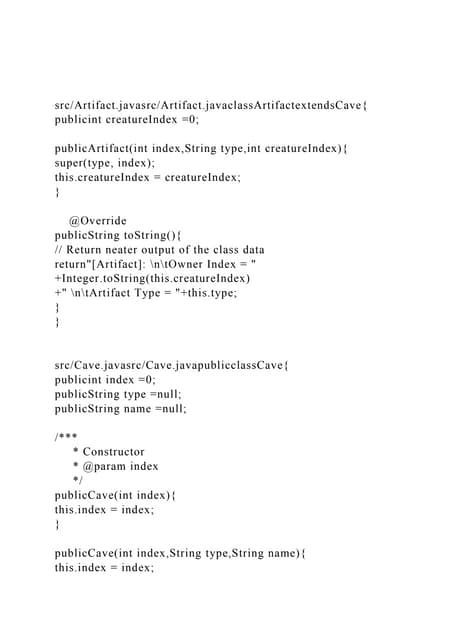



srcArtifact.javasrcArtifact.javaclassArtifactextendsCave{pub.docxwhitneyleman54422 src/Artifact.javasrc/Artifact.javaclassArtifactextendsCave{
publicint creatureIndex =0;
publicArtifact(int index,String type,int creatureIndex){
super(type, index);
this.creatureIndex = creatureIndex;
}
@Override
publicString toString(){
// Return neater output of the class data
return"[Artifact]: \n\tOwner Index = "
+Integer.toString(this.creatureIndex)
+" \n\tArtifact Type = "+this.type;
}
}
src/Cave.javasrc/Cave.javapublicclassCave{
publicint index =0;
publicString type =null;
publicString name =null;
/***
* Constructor
* @param index
*/
publicCave(int index){
this.index = index;
}
publicCave(int index,String type,String name){
this.index = index;
this.type = type;
this.name = name;
}
publicCave(int index,String name){
this.index = index;
this.name = name;
}
publicCave(String type,int index){
this.index = index;
this.type = type;
}
}
src/Creature.javasrc/Creature.javaimport java.awt.BorderLayout;
import java.awt.event.ActionEvent;
import java.awt.event.ActionListener;
import java.util.ArrayList;
import javax.swing.JButton;
import javax.swing.JFrame;
import javax.swing.JLabel;
import javax.swing.JOptionPane;
import javax.swing.JPanel;
import javax.swing.JProgressBar;
classCreatureextendsCaveimplementsActionListener,Runnable{
publicint partyIndex =0;
publicint empathyValue;
publicint fearValue;
publicdouble carryingCapacity;
publicint age;
publicint weight;
publicdouble height;
publicArrayList<Treasure> treasures =newArrayList<Treasure>();
publicArrayList<Artifact> artifacts =newArrayList<Artifact>();
publicArrayList<Jobs> jobs =newArrayList<Jobs>();
publiclong jobTime =0;
publicJobs currentJob =null;
publicvolatileboolean runJob =false;
publicvolatileboolean cancelJob =false;
JButton cancelButton =newJButton("Cancel Job");
JButton startButton =newJButton("Start Job");
publicCreature(int index,String type,String name,int partyIndex,
int empathyValue,int fearValue,double carryingCapacity){
super(index, type, name);
this.partyIndex = partyIndex;
this.empathyValue = empathyValue;
this.fearValue = fearValue;
this.carryingCapacity = carryingCapacity;
}
publicCreature(int index,String type,String name,int partyIndex,
int empathyValue,int fearValue,double carryingCapacity,int age,
int weight,double height){
super(index, type, name);
this.partyIndex = partyIndex;
this.empathyValue = empathyValue;
this.fearValue = fearValue;
this.carryingCapacity = carryingCapacity;
this.age = age;
this.weight = weight;
this.height = height;
}
publicvoid addTreature(Treasure t){
if(t !=null&& t instanceofTreasure&& t.creatureIndex !=0){
this.treasures.add(t);
}
}
publicvoid addArtifact(Artifact a){
if(a !=null&& a instanceofArtifact&& a.creatureIndex !=0){
this.artifacts.add(a);
}
}
@Override
publicString toString(){
String output ="";
output +="[Creature]: \n\tType = "+this.type +" \n\tName = "
+this.name +" \n\tParty Index = "
+Integer.toString(this.partyIndex)+" \n\tEmpathy Value = "
+Integer.toString(this.empathyV.
Lecture33



Lecture33David Evans The document discusses the evaluator for the Charme programming language. It compares the evaluator's core logic in Python and Java, showing they are similar. It explains how expressions are matched to expression types and evaluated. In particular, it discusses how name expressions are looked up by recursively searching the environment frames. Finally, it discusses how definitions are evaluated by adding name-value pairs to the current environment frame.
Scala



Scalasuraj_atreya Scala is a programming language that runs on the Java Virtual Machine (JVM) and is designed to express common programming patterns in a concise, elegant, and type-safe way. Some key points about Scala include that it is functional and object-oriented, statically typed, and allows seamless integration with Java. Scala code is often more concise than equivalent Java code through features like pattern matching and immutable data structures. Functional programming principles like pure functions, recursion, and avoiding side effects are emphasized in Scala.
Unit testing with PHPUnit



Unit testing with PHPUnitferca_sl Unit testing with PHPUnit allows developers to automate testing of classes and functions. Tests can validate expected outputs and behaviors and catch bugs. PHPUnit provides assertions to validate results and annotations to organize tests, mark them as incomplete, or specify expected exceptions. Fixtures can set up and tear down test environments and data. Writing thorough automated tests improves code quality and prevents regressions.
CodeCamp Iasi 10 march 2012 - Practical Groovy



CodeCamp Iasi 10 march 2012 - Practical GroovyCodecamp Romania This document provides an introduction to Groovy for Java developers. It discusses Groovy's features such as closures, optional typing and syntax, and how it compiles to Java bytecode. It then provides examples of writing a simple Groovy script to generate XML, using closures, mocking objects in tests, and building projects with Ant.
25-functions.ppt



25-functions.pptJyothiAmpally This document discusses JavaScript functions. It explains that functions are first-class objects that can be stored in variables, passed as arguments, and returned from other functions. It provides examples of defining, calling, and returning values from functions. It also covers optional parameters, anonymous functions, higher-order functions, and functions as methods.
JavaScript Classes and Inheritance



JavaScript Classes and Inheritancemarcheiligers A short introduction into prototypal inheritance in JS followed by a function to make it look like classical inheritance.
Learning Functional Programming Without Growing a Neckbeard



Learning Functional Programming Without Growing a NeckbeardKelsey Gilmore-Innis Slides from 12/13/12 presentation to SF Scala. Video: https://marakana.com/s/post/1354/learning_functional_programming_scala_video
Design patterns in javascript



Design patterns in javascriptMiao Siyu The document discusses various design patterns in JavaScript including creational patterns like constructor, prototype, and singleton patterns. It also covers structural patterns such as decorator, facade, and flyweight patterns as well as behavioral patterns like observer and mediator patterns. Examples are provided for how to implement common patterns like module, revealing module, observer, and decorator patterns in JavaScript code.
javascript prototype



javascript prototypeHika Maeng This document discusses JavaScript prototypes and the prototype chain. It provides examples of how to set up prototype chains between functions to inherit and share properties and methods. It also demonstrates how the prototype property works and how to access properties and methods from different levels in the prototype chain.
Ad
Recently uploaded (20)
Quantum Computing Quick Research Guide by Arthur Morgan



Quantum Computing Quick Research Guide by Arthur MorganArthur Morgan This is a Quick Research Guide (QRG).
QRGs include the following:
- A brief, high-level overview of the QRG topic.
- A milestone timeline for the QRG topic.
- Links to various free online resource materials to provide a deeper dive into the QRG topic.
- Conclusion and a recommendation for at least two books available in the SJPL system on the QRG topic.
QRGs planned for the series:
- Artificial Intelligence QRG
- Quantum Computing QRG
- Big Data Analytics QRG
- Spacecraft Guidance, Navigation & Control QRG (coming 2026)
- UK Home Computing & The Birth of ARM QRG (coming 2027)
Any questions or comments?
- Please contact Arthur Morgan at art_morgan@att.net.
100% human made.
Top 10 IT Help Desk Outsourcing Services



Top 10 IT Help Desk Outsourcing ServicesInfrassist Technologies Pvt. Ltd. IT help desk outsourcing Services can assist with that by offering availability for customers and address their IT issue promptly without breaking the bank.
How analogue intelligence complements AI



How analogue intelligence complements AIPaul Rowe
Artificial Intelligence is providing benefits in many areas of work within the heritage sector, from image analysis, to ideas generation, and new research tools. However, it is more critical than ever for people, with analogue intelligence, to ensure the integrity and ethical use of AI. Including real people can improve the use of AI by identifying potential biases, cross-checking results, refining workflows, and providing contextual relevance to AI-driven results.
News about the impact of AI often paints a rosy picture. In practice, there are many potential pitfalls. This presentation discusses these issues and looks at the role of analogue intelligence and analogue interfaces in providing the best results to our audiences. How do we deal with factually incorrect results? How do we get content generated that better reflects the diversity of our communities? What roles are there for physical, in-person experiences in the digital world?
Role of Data Annotation Services in AI-Powered Manufacturing



Role of Data Annotation Services in AI-Powered ManufacturingAndrew Leo From predictive maintenance to robotic automation, AI is driving the future of manufacturing. But without high-quality annotated data, even the smartest models fall short.
Discover how data annotation services are powering accuracy, safety, and efficiency in AI-driven manufacturing systems.
Precision in data labeling = Precision on the production floor.
Designing Low-Latency Systems with Rust and ScyllaDB: An Architectural Deep Dive



Designing Low-Latency Systems with Rust and ScyllaDB: An Architectural Deep DiveScyllaDB Want to learn practical tips for designing systems that can scale efficiently without compromising speed?
Join us for a workshop where we’ll address these challenges head-on and explore how to architect low-latency systems using Rust. During this free interactive workshop oriented for developers, engineers, and architects, we’ll cover how Rust’s unique language features and the Tokio async runtime enable high-performance application development.
As you explore key principles of designing low-latency systems with Rust, you will learn how to:
- Create and compile a real-world app with Rust
- Connect the application to ScyllaDB (NoSQL data store)
- Negotiate tradeoffs related to data modeling and querying
- Manage and monitor the database for consistently low latencies
AI Changes Everything – Talk at Cardiff Metropolitan University, 29th April 2...



AI Changes Everything – Talk at Cardiff Metropolitan University, 29th April 2...Alan Dix Talk at the final event of Data Fusion Dynamics: A Collaborative UK-Saudi Initiative in Cybersecurity and Artificial Intelligence funded by the British Council UK-Saudi Challenge Fund 2024, Cardiff Metropolitan University, 29th April 2025
https://alandix.com/academic/talks/CMet2025-AI-Changes-Everything/
Is AI just another technology, or does it fundamentally change the way we live and think?
Every technology has a direct impact with micro-ethical consequences, some good, some bad. However more profound are the ways in which some technologies reshape the very fabric of society with macro-ethical impacts. The invention of the stirrup revolutionised mounted combat, but as a side effect gave rise to the feudal system, which still shapes politics today. The internal combustion engine offers personal freedom and creates pollution, but has also transformed the nature of urban planning and international trade. When we look at AI the micro-ethical issues, such as bias, are most obvious, but the macro-ethical challenges may be greater.
At a micro-ethical level AI has the potential to deepen social, ethnic and gender bias, issues I have warned about since the early 1990s! It is also being used increasingly on the battlefield. However, it also offers amazing opportunities in health and educations, as the recent Nobel prizes for the developers of AlphaFold illustrate. More radically, the need to encode ethics acts as a mirror to surface essential ethical problems and conflicts.
At the macro-ethical level, by the early 2000s digital technology had already begun to undermine sovereignty (e.g. gambling), market economics (through network effects and emergent monopolies), and the very meaning of money. Modern AI is the child of big data, big computation and ultimately big business, intensifying the inherent tendency of digital technology to concentrate power. AI is already unravelling the fundamentals of the social, political and economic world around us, but this is a world that needs radical reimagining to overcome the global environmental and human challenges that confront us. Our challenge is whether to let the threads fall as they may, or to use them to weave a better future.
Big Data Analytics Quick Research Guide by Arthur Morgan



Big Data Analytics Quick Research Guide by Arthur MorganArthur Morgan This is a Quick Research Guide (QRG).
QRGs include the following:
- A brief, high-level overview of the QRG topic.
- A milestone timeline for the QRG topic.
- Links to various free online resource materials to provide a deeper dive into the QRG topic.
- Conclusion and a recommendation for at least two books available in the SJPL system on the QRG topic.
QRGs planned for the series:
- Artificial Intelligence QRG
- Quantum Computing QRG
- Big Data Analytics QRG
- Spacecraft Guidance, Navigation & Control QRG (coming 2026)
- UK Home Computing & The Birth of ARM QRG (coming 2027)
Any questions or comments?
- Please contact Arthur Morgan at art_morgan@att.net.
100% human made.
Build Your Own Copilot & Agents For Devs



Build Your Own Copilot & Agents For DevsBrian McKeiver May 2nd, 2025 talk at StirTrek 2025 Conference.
Semantic Cultivators : The Critical Future Role to Enable AI



Semantic Cultivators : The Critical Future Role to Enable AIartmondano By 2026, AI agents will consume 10x more enterprise data than humans, but with none of the contextual understanding that prevents catastrophic misinterpretations.
Social Media App Development Company-EmizenTech



Social Media App Development Company-EmizenTechSteve Jonas EmizenTech is a trusted Social Media App Development Company with 11+ years of experience in building engaging and feature-rich social platforms. Our team of skilled developers delivers custom social media apps tailored to your business goals and user expectations. We integrate real-time chat, video sharing, content feeds, notifications, and robust security features to ensure seamless user experiences. Whether you're creating a new platform or enhancing an existing one, we offer scalable solutions that support high performance and future growth. EmizenTech empowers businesses to connect users globally, boost engagement, and stay competitive in the digital social landscape.
The Evolution of Meme Coins A New Era for Digital Currency ppt.pdf



The Evolution of Meme Coins A New Era for Digital Currency ppt.pdfAbi john Analyze the growth of meme coins from mere online jokes to potential assets in the digital economy. Explore the community, culture, and utility as they elevate themselves to a new era in cryptocurrency.
Transcript: #StandardsGoals for 2025: Standards & certification roundup - Tec...



Transcript: #StandardsGoals for 2025: Standards & certification roundup - Tec...BookNet Canada Book industry standards are evolving rapidly. In the first part of this session, we’ll share an overview of key developments from 2024 and the early months of 2025. Then, BookNet’s resident standards expert, Tom Richardson, and CEO, Lauren Stewart, have a forward-looking conversation about what’s next.
Link to recording, presentation slides, and accompanying resource: https://bnctechforum.ca/sessions/standardsgoals-for-2025-standards-certification-roundup/
Presented by BookNet Canada on May 6, 2025 with support from the Department of Canadian Heritage.
Splunk Security Update | Public Sector Summit Germany 2025



Splunk Security Update | Public Sector Summit Germany 2025Splunk Splunk Security Update
Sprecher: Marcel Tanuatmadja
Are Cloud PBX Providers in India Reliable for Small Businesses (1).pdf



Are Cloud PBX Providers in India Reliable for Small Businesses (1).pdfTelecoms Supermarket Discover how reliable cloud PBX providers in India are for small businesses. Explore benefits, top vendors, and integration with modern tools.
Technology Trends in 2025: AI and Big Data Analytics



Technology Trends in 2025: AI and Big Data AnalyticsInData Labs At InData Labs, we have been keeping an ear to the ground, looking out for AI-enabled digital transformation trends coming our way in 2025. Our report will provide a look into the technology landscape of the future, including:
-Artificial Intelligence Market Overview
-Strategies for AI Adoption in 2025
-Anticipated drivers of AI adoption and transformative technologies
-Benefits of AI and Big data for your business
-Tips on how to prepare your business for innovation
-AI and data privacy: Strategies for securing data privacy in AI models, etc.
Download your free copy nowand implement the key findings to improve your business.
Web and Graphics Designing Training in Rajpura



Web and Graphics Designing Training in RajpuraErginous Technology Web & Graphics Designing Training at Erginous Technologies in Rajpura offers practical, hands-on learning for students, graduates, and professionals aiming for a creative career. The 6-week and 6-month industrial training programs blend creativity with technical skills to prepare you for real-world opportunities in design.
The course covers Graphic Designing tools like Photoshop, Illustrator, and CorelDRAW, along with logo, banner, and branding design. In Web Designing, you’ll learn HTML5, CSS3, JavaScript basics, responsive design, Bootstrap, Figma, and Adobe XD.
Erginous emphasizes 100% practical training, live projects, portfolio building, expert guidance, certification, and placement support. Graduates can explore roles like Web Designer, Graphic Designer, UI/UX Designer, or Freelancer.
For more info, visit erginous.co.in , message us on Instagram at erginoustechnologies, or call directly at +91-89684-38190 . Start your journey toward a creative and successful design career today!
Build 3D Animated Safety Induction - Tech EHS



Build 3D Animated Safety Induction - Tech EHSTECH EHS Solution Train Smarter, Not Harder – Let 3D Animation Lead the Way!
Discover how 3D animation makes inductions more engaging, effective, and cost-efficient.
Check out the slides to see how you can transform your safety training process!
Slide 1: Why 3D animation changes the game
Slide 2: Site-specific induction isn’t optional—it’s essential
Slide 3: Visitors are most at risk. Keep them safe
Slide 4: Videos beat text—especially when safety is on the line
Slide 5: TechEHS makes safety engaging and consistent
Slide 6: Better retention, lower costs, safer sites
Slide 7: Ready to elevate your induction process?
Can an animated video make a difference to your site's safety? Let's talk.
Ad


